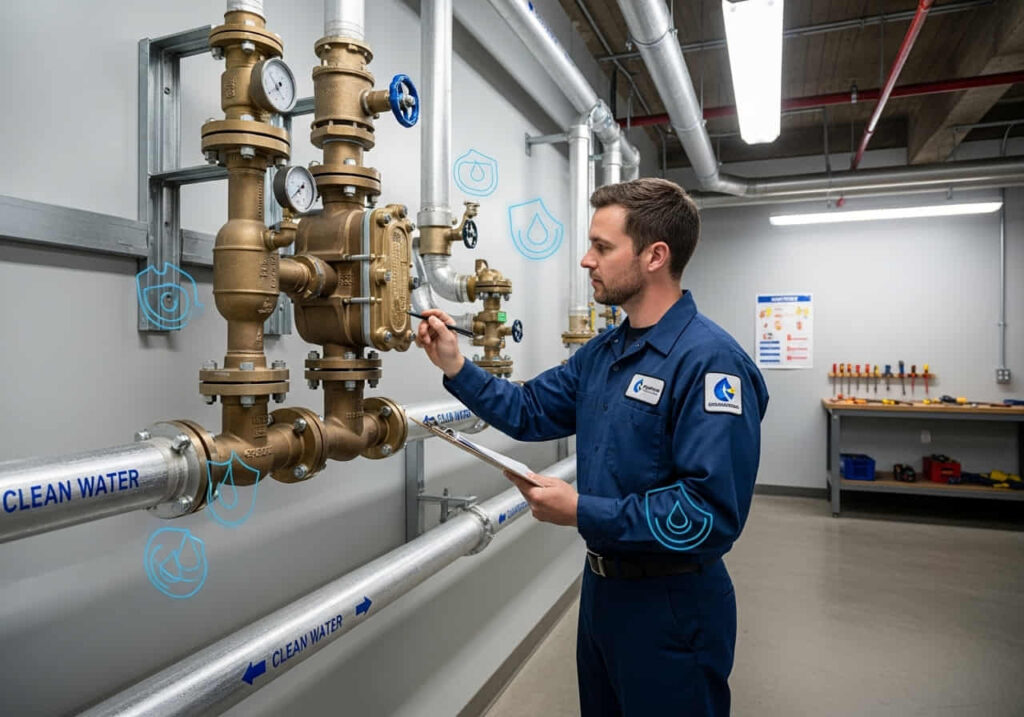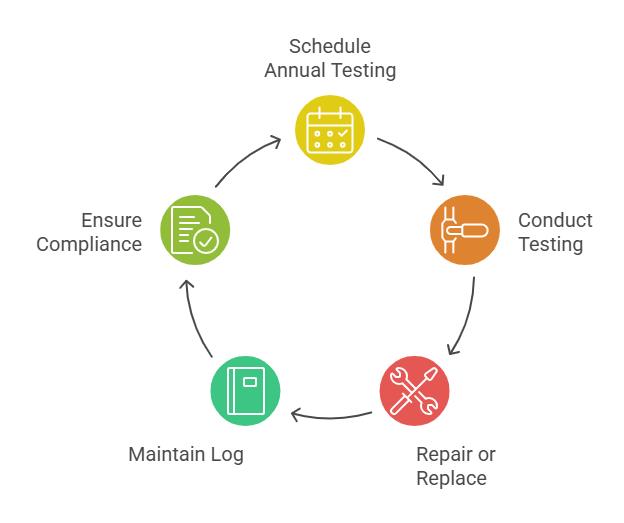
Backflow prevention keeps your facility’s water clean and safe by stopping dirty or hazardous water from flowing backward into your drinking-water pipes. In simple terms, it’s a one-way valve or barrier that makes sure water only flows in the intended direction. Without it, chemicals, fertilizers, sewage or bacteria from a hose, boiler or other source could contaminate the potable water your staff, customers and community rely on. By blocking that reverse flow, backflow prevention protects public health and avoids legal trouble (officials even impose fines or shut off service if a building violates these rules). In other words, a properly installed backflow device in your facility is your first line of defense against pollution and waterborne illness.
Understanding backflow is straightforward: it’s when water reverses direction due to pressure changes or system faults. For example, if a main water line breaks or a fire hydrant is used nearby, pressure can drop and pull water back (back-siphonage); or if pressure builds in a pump or boiler, it can push water backward (back-pressure). In either case, that reversed flow can suck contaminated water into your clean lines – the very water you drink, cook with, or wash.
Protecting People and Health
The main reason backflow prevention matters in any facility is health. Contaminated water can carry harmful substances that make people sick. For instance, pathogens in raw sewage or bacteria on garden hoses can enter your plumbing during a backflow event. Health experts warn that backflow incidents can cause “serious illness, disease and even death”. Infected employees, customers or patients could suffer anything from stomach flu to organ damage, especially the very young or elderly.
Backflow prevention devices act as a protective barrier. They ensure that dirty water from lawn irrigation, chemical tanks, pool hoses, boilers, or other sources cannot mix with your clean water. This keeps your facility’s drinking water pure. By stopping contaminants at their source, these devices maintain water quality and prevent outbreaks of waterborne illnesses. In short, installing and maintaining backflow preventers in your pipes is an easy, effective way to guard everyone’s health – employees, visitors, patients or students alike.
Avoiding Legal and Financial Trouble
Beyond health, backflow prevention is important because laws almost always require it in commercial or multi-use buildings. Many local and state codes mandate backflow devices for facilities like restaurants, factories, hospitals, labs, schools and more. These regulations exist precisely to protect public water systems. For example, New York City warns that failing to install, maintain or test required backflow devices “could result in fines or the disconnection of your water service”.
In practical terms, that means as a facility manager or business owner you can’t ignore backflow safety. Non-compliance can lead to citation from health departments, expensive penalties, or even forced shutdowns. Worse, a backflow contamination event could trigger costly lawsuits and remediation bills. Commercial properties facing a contamination issue may have to replace plumbing, decontaminate equipment, compensate victims, and spend thousands more on repairs. Preventing backflow is far cheaper than cleaning up a crisis. It’s also a matter of good reputation – customers and regulators will trust a business that takes water safety seriously.
Safeguarding Infrastructure and Operations
Besides human health and legal issues, backflow prevention protects your facility’s plumbing and equipment. Contaminants like chlorine, acids, rust inhibitors or fertilizers can corrode pipes, valves and appliances if they flow in the wrong direction. Over time, this can cause leaks, breakdowns, and system failures that disrupt operations. By keeping harmful substances out of your clean water lines, backflow devices help preserve the integrity of boilers, cooling towers, espresso machines, irrigation systems and more. In effect, they save you money on maintenance and downtime.
For example, an unchecked chemical backflow might eat away at a water heater or ruin a batch of food in a processing plant. One industry guide notes that the consequences of backflow in commercial settings include damage to plumbing systems, “costly remediation efforts” and liability for property loss. By contrast, a working check valve or air gap can prevent these scenarios. Think of backflow prevention as routine maintenance for your whole water system – it stops problems before they happen.
How Backflow Prevention Works
A variety of simple devices accomplish this one-way flow. Common types include check valves (which let water go forward but automatically close if flow reverses), air gaps (physical spaces that break the water connection), and more complex assemblies like double-check valves or reduced-pressure zone (RPZ) valves. For instance, an RPZ valve uses two check valves and a relief chamber; if either valve leaks, contaminated water is safely dumped out instead of entering the clean line. Vacuum breakers and pressure vacuum breakers are often used on irrigation systems or boilers. Each device is chosen based on the risk: low-hazard fixtures might use a simple check valve, while high-hazard connections (like a chemical feed line) require an RPZ assembly.
No matter the type, all backflow preventers share the same goal: only allow flow in one direction. They become an invisible but essential part of your plumbing. In many buildings, they’re installed at service entrances, near boiler fill lines, or on hose bibs. Even fixtures like dishwashers or fountains may have built-in vacuum breakers. The key is that every cross-connection (any place where non-potable water could meet clean water) needs a safeguard. Understanding your facility’s plumbing schematic and identifying these points helps ensure that the right devices are in place.

Maintenance and Testing Keep Devices Reliable
Installing backflow prevention is half the job; keeping it effective is the other half. Annual testing and maintenance are legally required in most areas. Licensed plumbers or certified testers will check that each valve holds pressure and that relief ports haven’t leaked. If a device fails, it must be repaired or replaced immediately. This routine checkup is like having an annual fire drill – it ensures that if a backflow situation ever occurs, your defenses work.
Regulations often demand proof of these tests. For example, New York City requires facility owners to have their preventers tested every 12 months by a certified tester, or risk fines and water shutoff. Many businesses include this in their compliance plan. A small plumbing investment each year can prevent a compliance headache later. Remember: a neglected backflow preventer is no better than none at all. By keeping a maintenance log and fixing any issues promptly, you’ll ensure continuous protection for your water supply.
FAQs
What causes backflow and why is it dangerous? Backflow happens when water pressure changes push or pull water in the wrong direction. For example, a burst main or heavy water use might suck contaminants backward. It’s dangerous because it can send bacteria, chemicals or waste right into your clean-water lines.
Which facilities need backflow prevention? Most commercial or industrial facilities do. Places with boilers, pools, labs, irrigation systems or chemical tanks are especially high-risk. In fact, many plumbing codes list hospitals, schools, factories, restaurants, auto shops, and other businesses as required to install backflow preventers. If your building connects to public water and has any cross-connection, it likely needs one.
How often do I need to test backflow devices? Typically, at least once a year. Most cities and states mandate annual testing by a licensed plumber or tester. After installation, you should test immediately to prove it works, and then keep up yearly tests. A consistent testing schedule ensures that if a backflow threat arises, your devices are ready to stop it.
What can enter the water through backflow? Many nasty things. Think bacteria and viruses from sewage or stagnant hoses, chemicals from cleaning or industrial processes, fertilizers or pesticides from irrigation, even heavy metals or corrosives from equipment. All of these belong on the other side of a backflow preventer – not in drinking water.
What happens if I ignore backflow prevention? Worst-case, someone gets hurt or your water supply is ruined. You could also face legal penalties. Health officials have recorded cases where entire communities fell ill due to backflow in one building. In a business setting, a contamination event could lead to evacuation, shutdown, lawsuits, and the cost of decontamination and repairs. It simply isn’t worth the risk.
In summary, backflow prevention is an invisible but vital part of your facility’s water system. It keeps your employees and customers safe, protects your property, and keeps you on the right side of the law. A small investment in the right devices and regular maintenance today will pay off in safety and peace of mind tomorrow. Remember: clean water is one of your most valuable resources – don’t let backflow jeopardize it.
